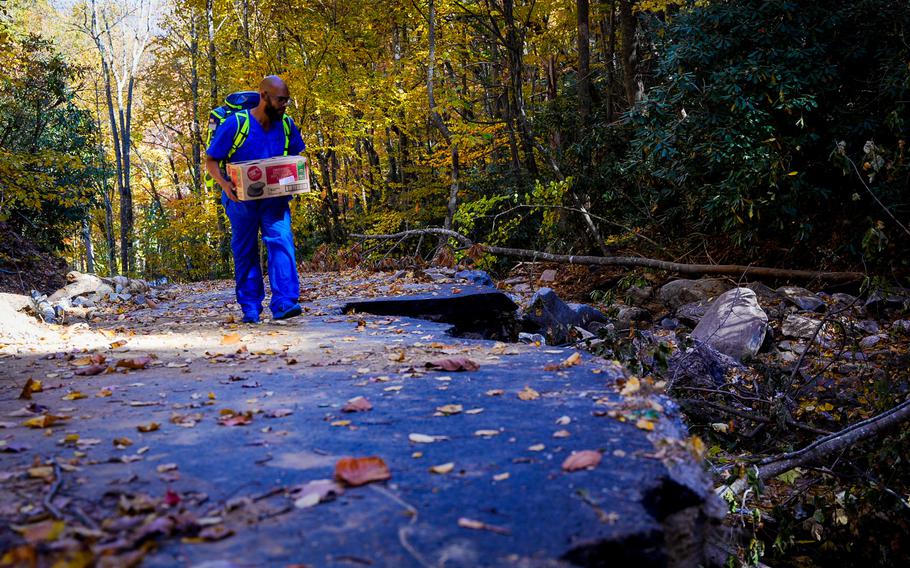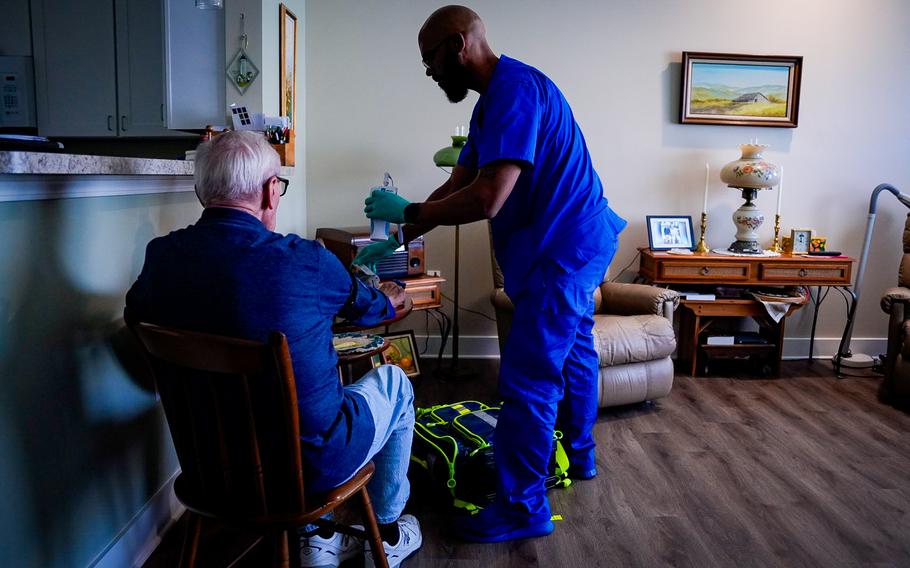
Corey Anderson, an intermediate care technician with the Department of Veterans Affairs in Asheville, N.C., carries medical supplies on a mountain road near the city, which was devastated by flooding and landslides from Hurricane Helene. (Kathie Ramos/Asheville VA)
The road leading to an 80-year-old military veteran’s mountain-top home outside Asheville, N.C., was still impassable more than two weeks after Hurricane Helene dumped devastating rainfall on the area, washing out roads, damaging bridges and spawning landslides.
But Corey Anderson, an intermediate health care technician with the Department of Veterans Affairs’ Asheville medical center, knew he needed to reach his patient.
So, the 15-year veteran of the Asheville VA’s emergency room parked his van, gathered his medical gear and a few supplies, and set out on foot to reach the veteran — a half-mile trek straight up the washed-away road pocked with downed trees.
“It didn’t feel like a choice. It’s like, there was no turning around and going back to the VA and saying, ‘I just couldn’t make it,’” Anderson said in a telephone interview this week. “That just couldn’t happen.”
At the mountain top, Anderson found his patient upbeat and doing well after the storm.
Neighbors had helped the veteran with supplies and to get a generator running for power. Neighbors even built a makeshift road after the storm, and Anderson was able to drive his van full of medical supplies to the veteran last week, he said.
For Anderson, it was just one of several of the house calls that he has made to check on elderly veterans in the weeks since Helene struck the area.
He is used to making such visits overseeing the Asheville VA program called Supporting Community Outpatient, Urgent Care, and Telehealth Services, or SCOUTS. The program sends VA medical professionals to visit elderly patients in the days and weeks after an emergency room visit.
Anderson’s trek to reach his patient is an example of the efforts of western North Carolina VA workers to help veterans in Helene’s aftermath, said Stephanie Young, who has served as the director of the Western North Carolina VA Health Care System since 2018.
Asheville VA workers, Young said, visited hundreds of veterans in the days and weeks after the storm. On one welfare check, they found a wheelchair-bound veteran in a flooded home who needed medical care and got him to the emergency room. In another instance, VA workers attempting to reach a more than 90-year-old disable veteran who was running low on medication realized the road to his home was impassable, so they enlisted the local fire department to help them reach his house via an all-terrain utility vehicle and delivered his medicine.
“I witnessed firsthand their unwavering commitment to veterans, and they upheld our [VA] mission, even as they struggled with their own personal losses. … So, not even a hurricane — not even Hurricane Helene could get in our staff’s way of caring for our veterans,” she said.

Corey Anderson, right, an intermediate care technician with the Department of Veterans Affairs medical center in Asheville, N.C., cares for a patient on Oct. 24, 2024. (Kathie Ramos/Asheville VA)
‘Whatever it takes’
When it became clear that Helene was likely to impact the Asheville area, Young sent the health care system, which includes Asheville’s Charles George medical center and three smaller VA clinics in Hickory, Franklin and Forest City, into its emergency preparedness plans. But no one could have predicted the immense damage Helene would unleash on Asheville after crossing some 500 miles from landfall as a Category 4 storm early Sept. 27 in northwest Florida’s Big Bend region, she said.
As the storm tore across Florida, Georgia, Tennessee, and North and South Carolina, it left its worst mark on Asheville and its surrounding areas — dumping as much as 31 inches of rainfall on the region in three days, including 15 inches on Sept. 27. It led to record flooding from rivers, including the Swannanoa and French Broad rivers and left Asheville’s popular River Arts District completely underwater.
The storm knocked out power to virtually the entire region, left tens of thousands without access to drinking water and knocked out cellphone communications for most in the area. Anderson said he was stuck in his home for a few days after the storm because of downed trees. His cellphone was not working, and he had no idea about the level of devastation in his surrounding community.
When Anderson set out for work after the storm, he was shocked by the amount of devastation that he saw.
“It looked like a tornado had just gone all the way through the whole town. It’s wild. Nothing I’d ever seen before,” he said. “Going down [Interstate] 70 into work, it’s like three feet of mud on the side of the road all the way down, houses destroyed, trees everywhere. I saw whole neighborhoods just gone. Communities just wiped away. It’s awful.”
Anderson spent the days after the storm delivering medicine, medical supplies, drinking water, body wipes and food to veterans throughout town, including to an apartment building where a handful of his patients, including a 99-year-old World War II veteran, lived on high floors and had no power or drinking water.
As an Army veteran, Anderson said he leaned on his military experiences to push through under the devastating circumstances. He served as an engineering equipment mechanic with the 1st Armored Division’s 40th Engineer Battalion, including a yearlong deployment to Iraq from 2005 to 2006. That experience, he said, prepared him to respond to Helene.
“One hundred percent, without question, it’s been helpful through this,” Anderson said. “It’s that mind frame of have and not need, versus need and not have, and really adapting and overcoming and being willing to do whatever it takes.”
Recovering after the storm
Young credited her staff with the VA systems quick recovery after the storm, which allowed them to get medical professionals quickly to veterans in need. The hospital has largely returned to normal operations since the storm, but it has continued to run on generator power because its normal utility power has yet to be fully restored.
The Western North Carolina VA system serves about 49,000 veterans in a 23-county swath of western North Carolina, and it boasts nearly 2,000 employees.
But even with dedicated workers and solid planning, Young said she could not foresee the response that would be needed after Helene.
Losing communications was the most difficult aspect of the storm, she said. With cellphone towers down and landlines not working through much of the region, Young had no choice but to send her employees out into the devastation to find veterans.
Once the hospital’s phones were working again, she said they started receiving hundreds of calls from family members and caretakers of local veterans asking for their help in checking on their statuses.
Young sent out so-called “tiger teams” — small groups of specialized care professionals — to check on high-risk veterans and see what they might need. Oxygen tanks, bottled water and medications topped the list. In one case, VA employees found a patient whose eyeglasses had broken in the storm. The patient had recently visited the VA for an eye appointment, and he had a pair of glasses that there were ready to be picked up. One of the VA employees went to the eye clinic, rifled through several drawers and found the man’s new glasses, Young said.
“We’re still doing these runs today,” she said Wednesday, almost a month after Helene hit. “Not anywhere near as much as we were originally, but we’re still there. We’re still doing this stuff.”
It is clear, Young said, that it will take years for the Asheville area to fully recover from Helene’s wrath. North Carolina Gov. Roy Cooper said Thursday that it would cost at least $52 billion to address storm damage in his state. Helene has been blamed for 96 deaths in North Carolina and the storm damaged or destroyed more than 200,000 homes, officials in the state have said.
On Friday, more than 600 roads remained closed in the Asheville area. Among them was a road off Interstate-40 that leads to the Charles George VA medical center.
“We’re getting back to normal,” Young said. “We’ll definitely get there. Our providers are working so hard to get everything up and running and to increase our number of surgical appointments. Our community center was never closed, and our hospital unit was never closed. It’s a testament, really, to the great work of our employees and how much they care about our veterans.”